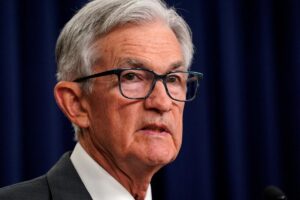Interest Rate Decisions and Economic Signals: A Closer Look
The Federal Reserve is navigating a complex landscape as it prepares for its upcoming meeting this week. With inflation still a pressing concern, officials seem inclined to hold interest rates steady amidst rising fears of an economic slowdown. Notably, President Donald Trump continues to exert pressure for rate cuts, complicating the Fed’s decision-making process.
Economic Data Paving the Way
Recent payroll data showed a notable increase of 177,000 jobs in April, providing some relief for Fed Chair Jerome Powell. The robust labor market strengthens the case for maintaining current rates, offering a buffer against external pressures. In addition, the Fed’s preferred inflation indicator reflects a gradual easing of price pressures, although rising U.S. import tariffs could jeopardize these gains.
Interestingly, Trump’s insistence on Powell’s job security persists even as he critiques the Fed’s rate policies. This uncertainty looms over central banks globally, especially as the White House seeks to negotiate tariffs that could drastically alter economic forecasts.
Inflation Expectations and Global Trends
Bloomberg economists predict that Powell will reiterate the Fed’s commitment to price stability. Concerns are mounting that inflation expectations may be softening, while recent employment figures lessen the urgency for immediate rate cuts.
Across the Atlantic, the European Central Bank (ECB) continues to lower rates in anticipation of disinflation linked to U.S. tariffs. Notably, euro-area inflation remained stable recently, defying expectations of decline, which adds another layer of complexity for policy-makers.
In Canada, newly elected Prime Minister Mark Carney’s meeting with Trump this week might shift the economic discussion towards tariffs, which will likely exert further influence on inflation data in both countries.
Upcoming Economic Indicators
This week, attention turns to a light calendar of U.S. economic data. Early readings from the Institute for Supply Management will provide insight into the service sector. Economists will be keen on jobless claims data, particularly concerning a spike in initial applications, which could point towards emerging layoffs and economic fragility.
Globally, several nations are set to announce monetary policy decisions, including anticipated cuts in the UK and Poland, while Brazil is expected to hike rates amidst heightened inflation pressures.
In Asia, China’s April trade data will command significant interest as it marks the first reporting period following new tariffs—an essential barometer for the extent of the trade war’s impact.
Conclusion
As we approach crucial rate decisions in various global economies, the interconnectedness of trade policies and monetary strategies becomes increasingly apparent. The challenges posed by tariffs stretch beyond immediate economic figures, potentially reshaping long-term financial landscapes. For investors and financial enthusiasts, staying informed on these developments is paramount, particularly in a climate brimming with unpredictability in central banking policies.
At Extreme Investor Network, we strive to deliver nuanced insights and actionable intelligence on market movements and economic conditions that shape your investment strategies. Stay tuned for more updates, as we keep a close eye on how global events influence local and international financial markets.

